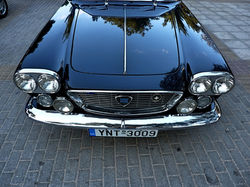
1968 Lancia Flavia PF Iniezione

All photography work is copyrighted by the author, please don't download and publish these pictures in the internet without my permission!
Larger high quality pictures is available only for donators up on request! Vasileios Papaidis 2017 © All Rights Reserved
Lancia Flavia is a medium-sized luxury saloon, launched with a 1500 cc engine at the 1960 Turin Motor Show by Lancia and introduced in major European markets during the next twelve months. Coupe and convertible versions developed by Pininfarina and Vignale quickly followed, together with one or two low volume 'specials' including an eye-catching Zagato coupe. Performance improved over the next ten years as the engine size increased, progressively, to 2000 cc. The car remained in production until 1970 when it was updated and renamed as the Lancia 2000.
The Lancia Flavia was developed by Professor Antonio Fessia in the late 1950s, and introduced for sale in the UK in 1961. Initially available only as a four-door saloon, it featured a 1.5 L aluminium boxer engine, Dunlop disc brakes on all four wheels, front-wheel drive and front suspension by unequal-length wishbones. This model was soon joined by a two-door coupé, designed by Pininfarina on a shortened platform. Vignale built a two-door convertible, while Zagato designed an outlandish-looking light weight two-door sport version. The sport version has twin carburetors for extra power (just over 100 hp/75 kW) however, this version of the engine was notoriously difficult to keep in tune. Even the single-carburettor engine suffered from the problem of timing chain stretch. Sprockets with vernier adjusters were fitted to allow for chain wear, and the cam timing was supposed to be checked every 6000 miles. Early cars also suffered from corrosion of the cylinder heads caused by using copper gaskets on aluminium heads; nevertheless, the car was quite lively for its day, considering the cubic capacity.
Later development of the engine included an enlargement to 1.8 L, a mechanical injection version using the Kugelfischer system, and a five-speed manual gearbox. Towards the end of the 1960s, when Fiat took control of the company, the Vignale and Zagato versions were discontinued. The coupé and saloon versions received new bodywork, first presented in March 1969 at the Geneva Motor Show.The engine increased to 2.0 L in capacity, available with carburetor or injection, and four- or five-speed gearbox. The 2.0 L models were only made with revised Pininfarina Coupe and revised Lancia Sedan bodies.


I like to thank my friend Alex Vazeos,with his car I participate at 9th Concours d' Elegance Greece 2012.This is a top gentleman ride I have ever drive,I adore this elegand Lancia,lovely memories brings me back this album!
Photo Gallery
 |  |  |
|---|---|---|
 |  |  |
 |  |  |
 |  |  |
 |  |  |
 |  |  |
 |  |  |
 |  |  |
 |  |  |
 |  |  |
 |

